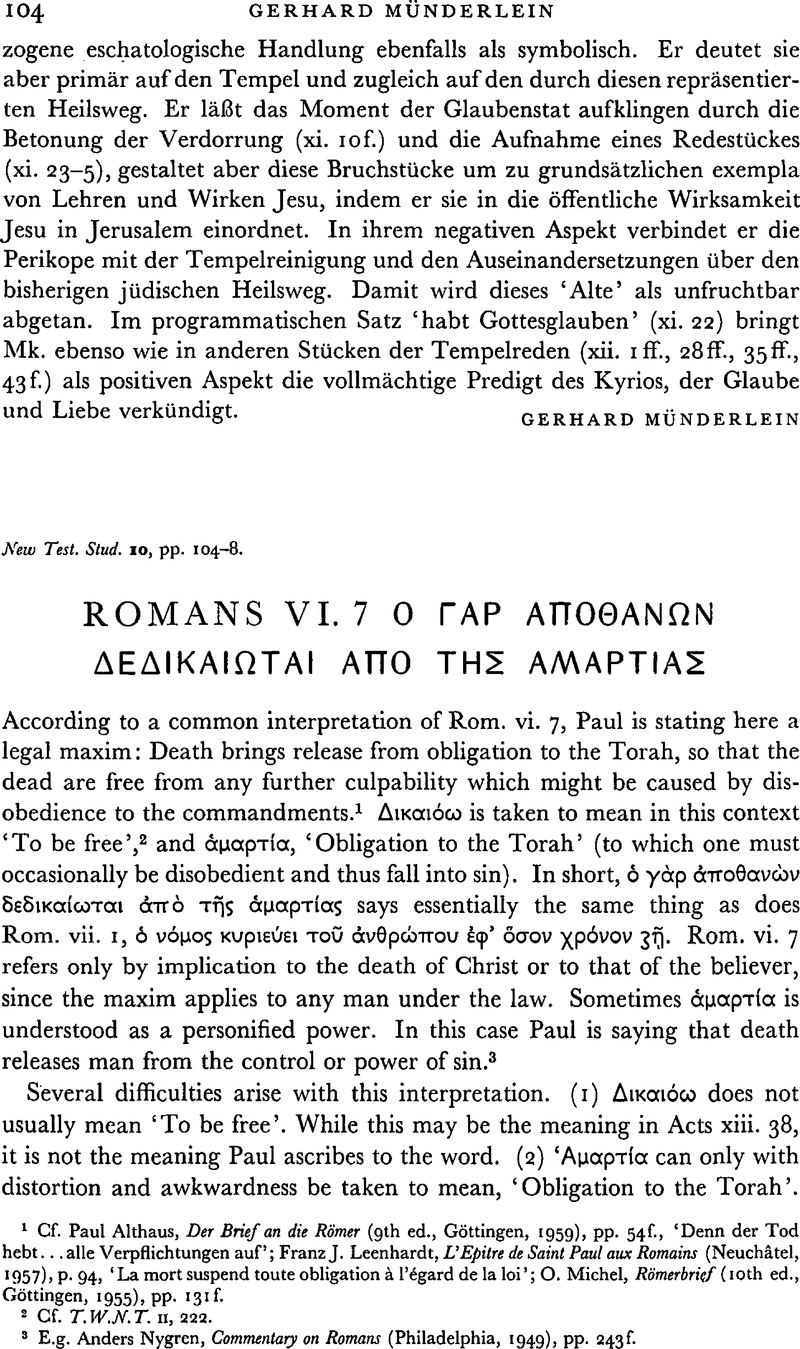Published online by Cambridge University Press: 05 February 2009

page 104 note 1 Cf. Althaus, Paul, Der Brief an die Römer (9th ed., Göttingen, 1959), pp. 54 f., ‘Denn der Tod hebt… alle Verpflichtungen auf’; Franz J. Leenhardt, L'Epitre de Saint Paul aux Romains (Neuchâtel, 1957), p. 94, ‘La mort suspend toute obligation à l'égard de la loi’; O. Michel, Römerbrief (10th ed., Göttingen, 1955), pp. 131 f.Google Scholar
page 104 note 2 Cf. T. W.N. T. II, 222.
page 104 note 3 E.g. Nygren, Anders, Commentary on Romans (Philadelphia, 1949), pp. 243 f.Google Scholar
page 105 note 1 Kuhn, K. G., ‘Rm 6, 7’, Z.X.W. xxx (1931), 305–10. Still another attempt to interpret the verse, this time by R. Reitzenstein from the standpoint of the mystery religions, seems to have been discarded by scholars and need not be discussed here, cf. Die Hellenistischen Mysterienreligionen (2nd ed.: Leipzig, 1920), pp. 115f.Google Scholar
page 105 note 2 Sifre Num. § 112, to Num. xv. 31.
page 105 note 3 jroma viii. 8, where there is some dispute as to what Rabbi Judah actually said. The conclusion is that Rabbi believed that death atones without repentance. Sifre Num. § 112, where the implication might be that only for the most serious sins is death without repentance inadequate a s a means of atonement.
page 106 note 1 Sifre Num. § 4; San. vi. 2; Ber. 60a; Mekiltato Exod. xx. 7 and parallels; Yoma viii. 8.
page 106 note 2 Yoma 86a, ![]() .
.
page 106 note 3 Parallels in Mekilta to Exod. xx. 7; T. Yoma iv. 8f.; A.R.N. N, 29.
page 106 note 4 San. vi. 2.
page 106 note 5 Rom. vi. 5.
page 106 note 6 Schweitzer has also suggested that the verse refers to the dying and rising with Christ, but his statement seems to have been generally ignored, cf. The Mysticism of Paul the Apostle (New York, 1955), P. 146.
page 106 note 7 Cf. Kuhn, Z.N.W. xxx, 308; W. D. Davies, Paul and Rabbinic Judaism (London, 1948), p. 272; Rudolf Mach, Der Zaddik, in Talmud und Midrasch (Leiden, 1957), pp. 133, 153 f.; H. J. Schoeps, Paul(Philadelphia, 1961), pp. 128–34.
page 107 note 1 IV Macc. xvii. 22; translation that of R. H. Charles, Apocrypha and Pseudepigrapha of the Old Testament (Oxford, 1913), II, 683.
page 107 note 2 Mekilta to Exod. xii. 1. Examples are given for Jonah, Moses and David. In jSan. xi. 5, a tradition ascribed to Simeon b. Yohai, commenting on I Kings xxii. 34, says that a drop of blood shed by ‘that righteous one’ atoned for all Israel. Who the righteous one can be is undecided. Ahab could not have been considered righteous; for suggestions, cf. E. Sjöberg, Gott und die Sünder im Palastinichen Judentum(Stuttgart, 1939), p. 175.
page 107 note 3 Somewhat similar logia are found in Gen. R. xliv. 5; Ber. 62 b; and Shab. 33 b.
page 107 note 4 M.K. 28a.
page 107 note 5 Pesikta xxvii (174b).
page 107 note 6 A late Midrash, ![]() , but the logion is attributed to R. Isaac.
, but the logion is attributed to R. Isaac.
page 107 note 7 Kommentar zum Neuen Testament aus Talmud und Midrasch (München, 1926), III, 261. Cf. also Sjöberg, p. 174.